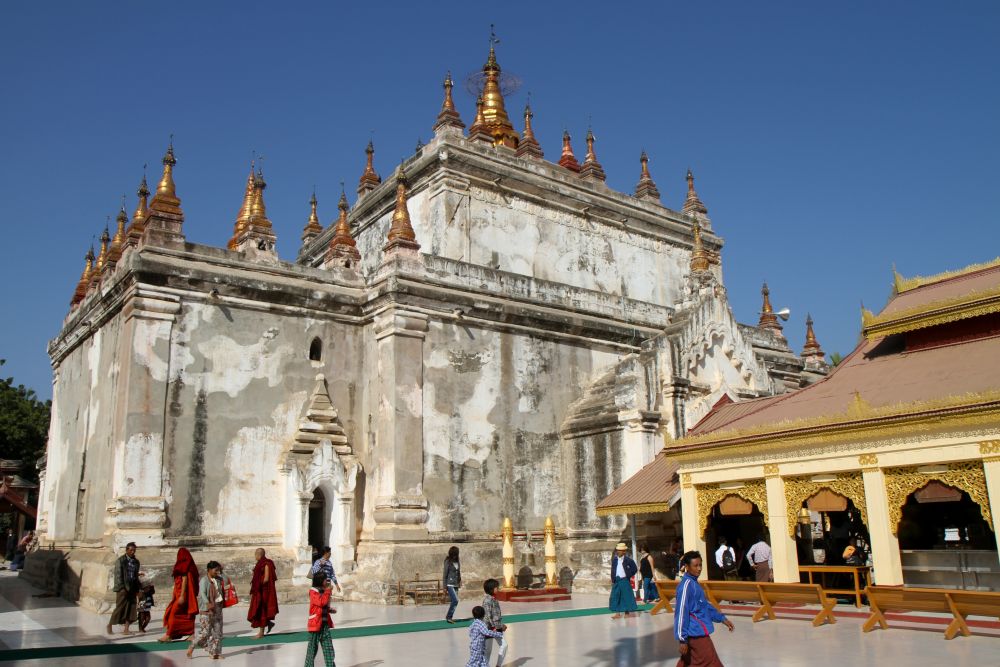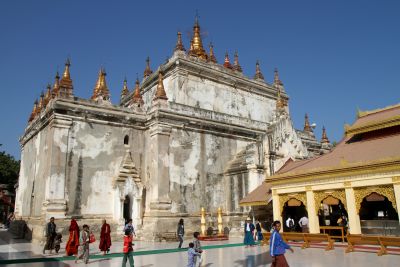

Manuha Temple is one of Bagan's many remarkable temples. Built by the Mon King Manuha in 1067, it is said to represent his captivity under the Bagan king. The temple is unique for housing unusually large Buddha statues in a relatively small space, symbolizing the King's discomfort. Visitors can explore the four seated and reclining Buddhas that fill the temple's chambers, almost touching the ceilings and walls. The atmosphere inside is somber yet peaceful. Devotees often come to pay their respects and add gold leaf to the statues. The temple architecture, with its elongated shape and the contrast between the compressed spaces and the gigantic Buddhas, offers a unique spiritual and historical perspective, conveying a sense of the king's frustration and his longing for release from suffering.
The ancient Manuha Temple offers photographers a wonderful opportunity to capture the essence of Bagan's religious and cultural heritage. With the temple's high ceilings, narrow corridors, and the play of light and shadow around the giant Buddha statues, photographers can find many captivating angles and compositions. Attending during less crowded times, such as early morning or later in the afternoon, brings out the quietude and grandeur of the temple. For those keen on photographing local culture, the temple is often visited by pilgrims and monks, allowing for respectful photography of religious practices. With the right guide or photography tour, enthusiasts can learn about optimal times for lighting and insights into capturing the essence of Manuha's Buddhas.
While Manuha Temple itself is not typically a sunset or sunrise viewing spot in comparison to other taller temples and pagodas in Bagan, its vicinity offers an opportunity to experience these magical moments. Visitors can find a nearby elevated area or temple terrace to see the sky change colors over the unique landscape dotted with ancient pagodas. With fewer tourists opting to watch the sunset or sunrise near Manuha, one can enjoy a more tranquil experience. Sunrise brings a serene start to the day, while sunset complements a day of exploration with a stunning backdrop. Those wishing to make the most out of this activity should prepare to arrive early or stay late and bring a map to navigate to and from Manuha Temple in the dark.
Exploring Manuha Temple with a local guide provides a deep dive into the temple's historical and cultural significance. A knowledgeable guide brings to life the story of King Manuha, his capture, and the expression of his personal suffering through the temple's design. The tour might cover other nearby temples, like the Nanpaya Temple, which is known for its intricate stone carvings. This activity is ideal for history buffs and those interested in the Mon architecture and Buddhist iconography. A cultural exploration tour often extends beyond the temple itself, providing insights into the local ways of life, art, and possibly a visit to a lacquerware workshop, one of Bagan's traditional crafts.
Manuha Temple is a serene place to engage in a meditation session. Visitors can reflect and meditate beside the colossal Buddha figures, which offer a sense of peace and confinement. The silence inside the temple's walls creates an ideal environment for contemplation. Some prefer solitary meditation, while others may wish to join a guided meditation session, often led by local monks or spiritual teachers. The experience allows participants to immerse themselves in Myanmar's Buddhist traditions and possibly learn about meditation techniques used by the monks. It's a way to connect with the spiritual history of the place while finding personal tranquility.
For the devout or those interested in religious practices, participating in a pilgrimage tour to Manuha Temple is a profound experience. The temple is still an active site of worship, where local Buddhists come to pay homage to the Buddha statues. Pilgrims often perform various rituals, such as offering flowers, lighting candles, and applying gold leaves to the statues. Visitors can observe or take part in these devotional activities, gaining insight into Myanmar's Buddhist traditions. The experience is particularly enriching during Buddhist festivals or holy days when the temple comes alive with chanting, prayers, and various religious ceremonies.
Organized by local historians or cultural centers, a historical lecture and workshop at Manuha Temple can provide a scholarly overview of the temple's past and its place within Bagan's architectural ensemble. These activities often include discussions on Bagan's history, the Mon kingdom influence, and the artistic importance of the temple's murals and Buddha images. Workshops might focus on the preservation efforts, archaeological methods, or religious iconography. This educational activity is typically designed for those with a keen interest in history, archaeology, and art history. It's a unique way to enhance one's understanding of this ancient site.
While not within the temple itself, a traditional Burmese cooking class can be organized in the nearby village. Participants learn about local ingredients, techniques, and flavors inherent to Burmese cuisine. These classes often include a market visit to source fresh produce, followed by hands-on instruction on how to prepare several dishes. A cooking class offers a delightful way to engage with Bagan's culture and enjoy a communal meal with fellow travelers or locals. Classes might include making popular dishes such as tea leaf salad, Mohinga, or Burmese curry, which participants can later enjoy for lunch or dinner.
Outside Manuha Temple, visitors will find small stalls and shops selling locally made handicrafts. Shopping here supports the local economy and artists who specialize in making traditional lacquerware, wood carvings, sand paintings, and textiles. Depending on the shop, visitors can sometimes witness artisans at work and even try their hand at some of the simpler crafting techniques. Purchasing these items not only serves as a memento of the visit to Manuha Temple but also helps preserve the artisanal crafts that have been part of Bagan's culture for centuries.
For a more active exploration, a bicycle tour around Manuha Temple allows visitors to enjoy the surrounding landscapes and discover other nearby temples at a leisurely pace. Bicycling provides a sense of freedom and intimacy with the environment that's not always possible with motorized transport. Rental shops nearby offer bicycles for hire, and some guided tours include stops at lesser-known sites for a more comprehensive understanding of the area. This is an environmentally friendly and health-conscious way to experience the Bagan region, suitable for most fitness levels.
